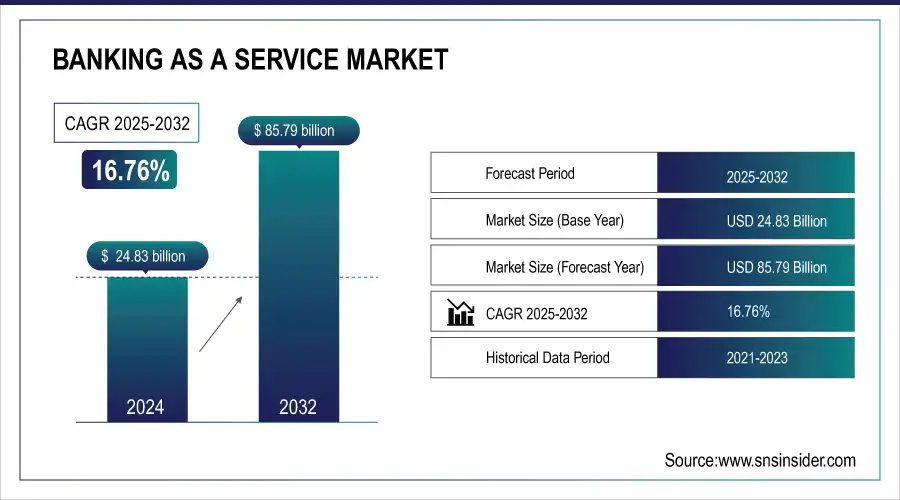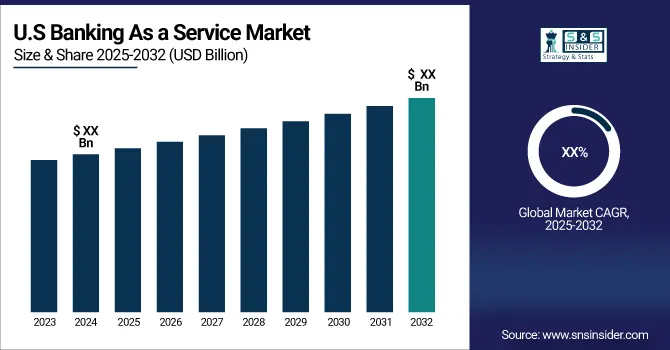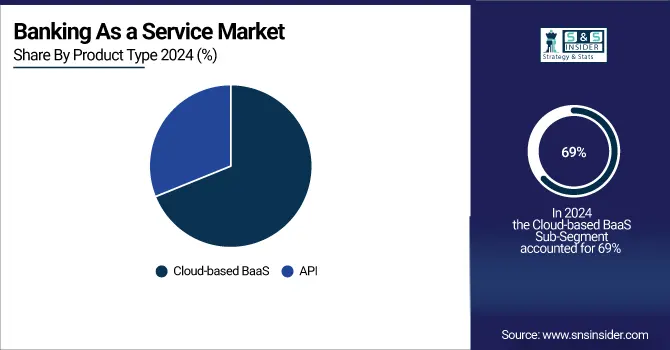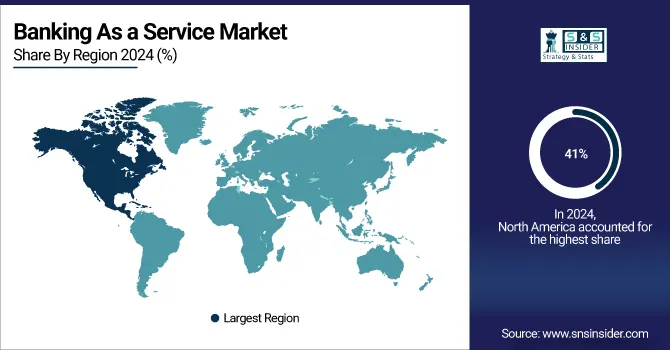Banking As a Service Market Report Scope and Overview:
The Banking As a Service Market size was USD 24.83 Billion in 2024 and is expected to Reach USD 85.79 billion by 2032 and grow at a CAGR of 16.76% over the forecast period of 2025-2032.
The Banking as a Service (BaaS) market has emerged as a crucial facilitator of digital transformation in the financial sector, enabling financial institutions and businesses to meet the growing demand for efficient, accessible, and integrated financial services. As organizations and consumers increasingly seek digital solutions, the BaaS model has gained significant traction, offering a framework that allows businesses to deliver banking services without the complexities of traditional banking infrastructures. According to a recent study, 55% of banks cite legacy systems as the top barrier to transformation, emphasizing the urgent need for modern solutions.The rise of fintech has drastically changed how financial services are offered, pushing traditional banks to collaborate with technology providers to innovate and adapt to a rapidly evolving market. By leveraging BaaS, institutions can introduce new financial products and services quickly, responding to consumer needs and market trends in real-time. This speed of service delivery is critical as customers now expect seamless, convenient banking experiences, akin to those offered by leading technology companies.

Get More Information on Banking As a Service Market - Request Sample Report
Banking As a Service Market Size and Forecast:
-
Market Size in 2024: USD 24.83 Billion
-
Market Size by 2032: USD 85.79 Billion
-
CAGR: 39.36% from 2025 to 2032
-
Base Year: 2024
-
Forecast Period: 2025–2032
-
Historical Data: 2021–2023

Banking As a Service Market Highlights:
-
Digital transformation and BaaS integration enable companies to embed financial functionalities like payments, account management, and lending directly into applications, enhancing customer engagement and operational efficiency
-
Operational efficiency and innovation are supported as BaaS allows businesses to streamline operations, reduce costs, focus on core competencies, and develop tailored financial solutions through partnerships with specialized providers
-
Regulatory compliance support is enhanced as many BaaS platforms come with built-in compliance features, helping financial institutions meet requirements across jurisdictions while offering innovative products
-
Cybersecurity challenges rise as reliance on digital platforms grows, necessitating robust protocols to protect sensitive financial data and maintain customer trust
-
Market drivers include rising consumer expectations where BaaS helps banks meet demands for seamless, personalized digital experiences, with 71% of consumers expecting services comparable to tech giants and 62% preferring online channels
-
Market restraints include data security concerns since sharing financial data with third-party providers raises privacy risks, with 75% of financial organizations citing data security as a top concern, highlighting the need for stringent safeguards and secure cloud solutions
Digital transformation serves as a catalyst for business growth, and Banking as a Service plays a vital role in this evolution. Companies can integrate financial functionalities, such as payment processing, account management, and lending services, directly into their applications, thereby enhancing customer engagement and retention. By utilizing Banking as a Service platforms, businesses can also streamline their operations, reduce costs, and focus on their core competencies while leaving the complex banking functions to specialized providers. This model supports greater innovation in the banking industry, allowing for the development of tailored solutions that meet specific customer demands. To further emphasize the significance of BaaS in the banking landscape, many organizations are prioritizing partnerships with BaaS providers to navigate the complexities of regulatory compliance while also providing innovative financial products. Such partnerships enable banks to scale their operations quickly and effectively, enhancing their competitive positioning in the market. In addition, Banking as a Service platforms often come with built-in compliance features, allowing institutions to meet the regulatory requirements of various jurisdictions with ease.
Despite the evident benefits of Banking as a Service, challenges persist, particularly concerning cybersecurity. As banks and fintechs increasingly rely on digital platforms, the risk of cyberattacks rises, necessitating robust security measures to protect sensitive financial data. Organizations must invest in advanced cybersecurity protocols to safeguard against breaches and maintain customer trust, which is essential in an era where data security is paramount. The Middle East and Africa (MEA) region is witnessing a notable surge in Banking as a Service adoption, fueled by a young, tech-savvy population and government initiatives aimed at promoting fintech innovation. For instance, the launch of ADIB Ventures by Abu Dhabi Islamic Bank is a testament to the commitment of regional banks to drive fintech growth. By supporting startups and embracing digital transformation, banks in the MEA region can not only enhance their service offerings but also contribute to the broader economic growth of their countries. The Banking as a Service market is at the forefront of the digital transformation sweeping across the financial services sector. With the pressure to innovate and deliver superior customer experiences, financial institutions are increasingly leveraging Banking as a Service to overcome legacy system challenges and embrace a more agile and efficient operational model. As the market continues to evolve, collaboration between banks and technology providers will be vital in shaping the future of banking. The rapid growth of Banking as a Service indicates a robust trend towards a more integrated and accessible financial ecosystem, positioning it as a cornerstone of modern banking solutions.
Banking As a Service Market Drivers:
- Meeting the Rising Tide of Consumer Expectations in Banking
As consumer expectations continue to evolve, the banking sector faces increasing pressure to provide seamless and personalized experiences. Recent trends indicate that 71% of consumers expect their financial institutions to offer the same level of service and convenience as tech giants like Amazon and Apple. This shift is primarily driven by the growing reliance on digital channels, with 62% of banking customers now preferring online services over traditional methods. Banking as a Service (BaaS) platforms are uniquely positioned to meet these demands, enabling institutions to rapidly develop and deploy innovative services that enhance customer satisfaction and loyalty. A recent report highlights that 80% of banking executives recognize the urgency to adapt to these heightened expectations, as failing to do so could result in losing market share to more agile competitors. Additionally, as inflation remains a concern, with the Consumer Price Index increasing by 0.2%, consumers are seeking more value from their banking relationships. In this landscape, Banking as a Service not only streamlines service delivery but also empowers banks to offer tailored solutions that resonate with today's consumers, ultimately driving growth and retention in a highly competitive market.
Banking As a Service Market Restraints:
- Navigating Data Security Concerns in the Banking as a Service Market
In the rapidly evolving landscape of Banking as a Service (BaaS), data security concerns have emerged as a critical restraint. The inherent nature of BaaS involves sharing sensitive financial information between banks and third-party providers, raising significant risks regarding data privacy. With cyberattacks on the rise, a single security breach can lead to severe repercussions for financial institutions, jeopardizing customer trust and tarnishing reputations. Recent insights highlight that 75% of financial organizations cite data security as a top concern, emphasizing the need for robust cybersecurity measures. Moreover, incidents such as Bank of America's recent customer account lockouts illustrate the vulnerabilities inherent in digital banking systems. Additionally, 60% of banks are actively seeking private cloud solutions to enhance cost efficiency while bolstering data security, indicating a shift toward more secure environments. However, navigating regulatory compliance and maintaining consumer confidence in data protection remain challenges that BaaS providers must address. As the market continues to grow, establishing stringent data security protocols will be paramount for financial institutions to safeguard their operations and retain customer loyalty.
Banking As a Service Market Segment Analysis:
By Product Type
Cloud-based Banking as a Service (BaaS) solutions are leading the BaaS market, capturing approximately 69% of total market share in 2024. This dominance stems from the scalability, flexibility, and cost-effectiveness of cloud technologies, allowing banks and fintech firms to rapidly launch new services and improve operational efficiency while minimizing infrastructure costs. Recent innovations include Solarisbank’s 2024 launch of an enhanced cloud-based platform that enables seamless banking service integration, Green Dot Bank’s 2023 suite designed for small businesses that provide integrated payment solutions, and N26's expansion into the U.S. market to serve tech-savvy consumers.In terms of regional development, the United States remains a front-runner in cloud-based BaaS adoption, driven by a robust fintech presence and supportive regulatory frameworks. Europe, particularly Germany and the UK, is also experiencing significant growth due to the EU's Digital Finance Strategy, which fosters cloud adoption and Open Banking initiatives. Meanwhile, the Asia Pacific region, led by Singapore and Australia, is encouraging banks to adopt cloud technologies through regulatory support. As the BaaS market evolves, cloud-based solutions will continue to dominate, although on-premises and hybrid models remain relevant for institutions with strict security needs.

By Platform
The Banking as a Service (BaaS) market has experienced substantial growth, with the platform segment holding about 74% of the market share in 2024. This leadership is primarily due to the rising demand for integrated banking solutions that provide seamless access to diverse financial services. The platform segment includes a variety of services such as APIs, application development tools, and cloud infrastructure, which enable financial institutions and fintech companies to efficiently build, deploy, and manage banking applications. Key drivers of platform adoption include enhanced integration capabilities, which allow for the incorporation of banking services into existing applications, accelerating time-to-market for new products, and cost savings on infrastructure for startups and small businesses. Recent developments highlight innovations from key players: Solarisbank has improved its platform for seamless fintech integrations, Green Dot Bank has tailored its offerings for small businesses, and Fidor Solutions continues to enhance functionality through advanced APIs. Regionally, the U.S. leads in BaaS platform adoption, followed by significant growth in Europe and Asia Pacific, driven by regulatory support and a focus on financial inclusion. The platform segment's continued advancements will play a vital role in transforming the banking landscape to meet evolving consumer needs.
Banking As a Service Market Regional Analysis:
North America Banking As a Service Market Trends:
North America is a major player in the Banking as a Service (BaaS) market, capturing approximately 41% of the total revenue share in 2023. This dominance stems from a strong fintech ecosystem, favorable regulatory frameworks, and high technological adoption among financial institutions. The United States is home to numerous innovative fintech startups that rapidly leverage BaaS solutions to meet consumer demands and market trends, fostering competition and growth. Regulatory initiatives, such as "Banking as a Service 2.0," encourage collaboration between traditional banks and fintech firms, promoting the adoption of digital banking solutions while ensuring consumer protection. North American financial institutions are also quick to adopt advanced technologies like cloud computing and artificial intelligence, enhancing operational efficiency and customer experiences. As consumers increasingly demand seamless, personalized banking solutions, Banking as a Service platforms enable financial institutions to deliver tailored services that align with evolving expectations. Recent developments, such as Solarisbank’s enhanced platform and Green Dot Bank’s offerings for small businesses, illustrate the region's commitment to innovation. With a combination of strong fintech support, regulatory backing, and consumer demand, North America is poised for sustained growth in the Banking as a Service market, solidifying its position as a leader in the global financial services landscape.

Do You Need any Customization Research on Banking As a Service Market - Inquire Now
Asia-Pacific Banking As a Service Market Trends:
Asia Pacific is rapidly emerging as the fastest-growing region in the Banking as a Service (BaaS) market, driven by significant digital transformation, increasing fintech adoption, and favorable regulatory frameworks. In 2023, countries like China, India, and Singapore are leading a digital revolution in finance, where a surge of fintech companies is fostering competition and innovation, thus driving demand for BaaS solutions. Regulatory bodies, such as Singapore’s Monetary Authority, are implementing policies to support digital banking solutions and facilitate partnerships between traditional banks and fintech firms. Moreover, BaaS platforms address the critical issue of financial inclusion, providing tailored banking services to unbanked and underbanked populations in rural areas. With substantial investments in technology, including cloud computing and artificial intelligence, financial institutions in the region are enhancing operational efficiency while meeting the growing consumer demand for convenient and personalized banking experiences. Recent developments, like Kookmin Bank’s new BaaS platform in South Korea and Grab Financial Group’s enhanced offerings, illustrate the dynamic nature of this market. Additionally, government initiatives such as India’s Digital India Program are promoting digital financial literacy, while Australia’s regulatory bodies foster innovation, positioning Asia Pacific as a pivotal player in reshaping the future of banking services.
Europe Banking as a Service Market Trends:
Europe represents a mature and highly competitive BaaS market, driven by robust regulatory initiatives, advanced digital infrastructure, and strong adoption of open banking practices. The region benefits from the EU’s PSD2 (Payment Services Directive 2), which mandates banks to open APIs for third-party providers, fueling innovation and collaboration between banks and fintechs. Countries like the UK, Germany, and France lead the charge, with fintech hubs such as London and Berlin fostering startups and scale-ups in the BaaS space. The demand for embedded finance solutions is rising, with corporations across retail, e-commerce, and travel sectors integrating financial services into their ecosystems. Moreover, European consumers exhibit high digital banking adoption rates, pushing traditional banks to leverage BaaS platforms to stay competitive. Recent developments, such as Railsr’s embedded finance solutions and Tink’s expanded account aggregation services, highlight the region’s dynamic ecosystem. With strong regulatory support, consumer trust in digital banking, and continuous fintech innovation, Europe remains a frontrunner in shaping the global BaaS landscape.
Latin America Banking as a Service Market Trends:
Latin America is witnessing rapid growth in the BaaS market, propelled by financial inclusion initiatives, a booming fintech sector, and digital payment adoption. A large portion of the population remains unbanked or underbanked, creating strong demand for accessible financial services powered by BaaS platforms. Countries such as Brazil, Mexico, and Colombia are at the forefront, with regulators introducing frameworks to support fintech–bank partnerships and expand digital banking services. The rise of mobile-first solutions and super-apps is further accelerating consumer adoption. For instance, Brazil’s Open Banking initiative and Mexico’s Fintech Law provide regulatory clarity and encourage innovation. BaaS platforms enable fintechs and non-financial companies to launch digital wallets, credit solutions, and payment processing systems quickly, filling gaps left by traditional banks. Recent developments, such as Nubank’s digital expansion and Ualá’s partnerships with BaaS providers, demonstrate the momentum in the region. With its youthful, tech-savvy population and regulatory focus on inclusion, Latin America is set to become one of the most dynamic markets for BaaS.
Middle East & Africa Banking as a Service Market Trends:
The Middle East & Africa region is gradually gaining traction in the BaaS market, driven by growing smartphone penetration, digital transformation, and government-backed financial inclusion programs. Countries such as the UAE, Saudi Arabia, Nigeria, and South Africa are leading adoption, supported by strong fintech ecosystems and favorable regulatory reforms. In the Middle East, initiatives like Saudi Arabia’s Vision 2030 and the UAE’s Smart Dubai program promote digital banking and fintech innovation, while in Africa, BaaS platforms are addressing the critical need for accessible banking in underserved populations. Mobile money services, such as M-Pesa in Kenya, illustrate how technology bridges financial gaps, and BaaS is extending these innovations with new credit, payments, and remittance solutions. Recent developments, like Tarabut Gateway’s API-driven platform in the Gulf region and partnerships between African fintechs and BaaS providers, showcase the market’s rapid evolution. With continued investments in digital infrastructure and regulatory support, the Middle East & Africa are positioned to unlock significant growth opportunities in the global BaaS ecosystem.
Banking As a Service Market Key Players:
-
Green Dot Bank (Prepaid Cards, Mobile Banking, and Financial Technology Solutions)
-
Solarisbank AG (API-driven BaaS Platform, Digital Banking Infrastructure)
-
PayPal Holdings, Inc. (Digital Payments, Peer-to-Peer Payments, BaaS Solutions)
-
Fidor Solutions AG (Open API Banking, Digital Banking Platform)
-
Moven Enterprise (Financial Wellness Tools, Digital Banking Solutions)
-
The Currency Cloud Ltd. (Cross-Border Payments, Multi-Currency Accounts)
-
Treezor (White-Label BaaS Platform, Payment Processing)
-
Match Move Pay Pte Ltd. (Digital Wallets, Prepaid Cards, BaaS Solutions)
-
Block, Inc. (formerly Square, Inc.) (Digital Payments, Financial Services Infrastructure)
-
Bnkbl Ltd. (formerly Bankable) (White-Label Banking Solutions, Payment Systems)
-
ClearBank (Cloud-Based Clearing Bank, API Banking)
-
Railsr (formerly Railsbank) (Embedded Finance Platform, Open Banking)
-
Marqeta, Inc. (Card Issuing, Payment Processing, BaaS Solutions)
-
Tink AB (Open Banking Platform, Account Aggregation)
-
Finastra (Financial Software, Open Banking Solutions)
-
Temenos (Core Banking Software, Digital Banking Solutions)
-
Plaid (API Connectivity for Financial Services, Open Banking)
-
BBVA Open Platform (APIs for Payments, Accounts, and Cards)
-
10x Banking (Cloud-Native Core Banking Platform)
-
Synctera (Bank-Fintech Partnership Platform, BaaS Solutions)
Banking As a Service Market Competitive Landscape:
Avidia Bank, established in 2007, is a community-focused financial institution headquartered in Massachusetts, USA. It offers retail and commercial banking services, digital banking solutions, and payment innovations. Known for its collaboration with fintech firms, Avidia supports Banking-as-a-Service (BaaS) initiatives, delivering secure, technology-driven financial solutions to individuals, businesses, and partners nationwide.
-
In July 2024, Avidia Bank formed partnership with Q2 Software Inc, for digital banking platform. Avidia will upgrade its online banking capabilities and adopt Personetic’s AI-powered engagement engine through its partnership with Q2 digital banking platform. This will allow Avidia to provide real-time insights and automated saving plans.
Saudi Central Bank (SAMA), established in 1952, is the central financial authority of Saudi Arabia. It regulates banking, insurance, and financial institutions, ensuring stability and transparency in the financial sector. SAMA also promotes digital banking initiatives, fintech adoption, and Banking-as-a-Service (BaaS) frameworks to support innovation and financial inclusion nationwide.
-
In July 2024, Saudi Central Bank (SAMA) launched a new government banking service platform named “Naqd”. The platform will enable government agencies to easily access their accounts at the central bank as well as conduct secure financial transactions on a digital platform.
Wealthify, a UK-based digital investment platform founded in 2016, provides easy-to-use, automated investment solutions for retail investors. Focused on simplicity and accessibility, Wealthify combines technology and expert portfolio management. Through its partnership with ClearBank, it leverages Banking-as-a-Service (BaaS) infrastructure to enhance payment processing and streamline financial operations for its clients.
-
In February 2024, UK-based digital investment platform Wealthify formed partnership with ClearBank. The former company will leverage ClearBank’s embedded banking service to introduce a new instant-access savings account.
| Report Attributes | Details |
|---|---|
| Market Size in 2024 | USD 24.83 Billion |
| Market Size by 2032 | USD 85.79 Billion |
| CAGR | CAGR of 39.36%From 2025 to 2032 |
| Base Year | 2024 |
| Forecast Period | 2025-2032 |
| Historical Data | 2021-2023 |
| Report Scope & Coverage | Market Size, Segments Analysis, Competitive Landscape, Regional Analysis, DROC & SWOT Analysis, Forecast Outlook |
| Key Segments |
• By Product Type (API, Cloud-based BaaS) •By End-User (Banks, FinTech, Corporation, NBFC, Others) |
| Regional Analysis/Coverage | North America (US, Canada, Mexico), Europe (Eastern Europe [Poland, Romania, Hungary, Turkey, Rest of Eastern Europe] Western Europe] Germany, France, UK, Italy, Spain, Netherlands, Switzerland, Austria, Rest of Western Europe]), Asia-Pacific (China, India, Japan, South Korea, Vietnam, Singapore, Australia, Rest of Asia-Pacific), Middle East & Africa (Middle East [UAE, Egypt, Saudi Arabia, Qatar, Rest of Middle East], Africa [Nigeria, South Africa, Rest of Africa], Latin America (Brazil, Argentina, Colombia, Rest of Latin America) |
| Company Profiles |
Green Dot Bank, Solarisbank AG, PayPal Holdings, Inc., Fidor Solutions AG, Moven Enterprise, The Currency Cloud Ltd., Treezor, Match Move Pay Pte Ltd., Block, Inc., Bnkbl Ltd., ClearBank, Railsr, Marqeta, Inc., Tink AB, Finastra, Temenos, Plaid, BBVA Open Platform, 10x Banking, Synctera |

